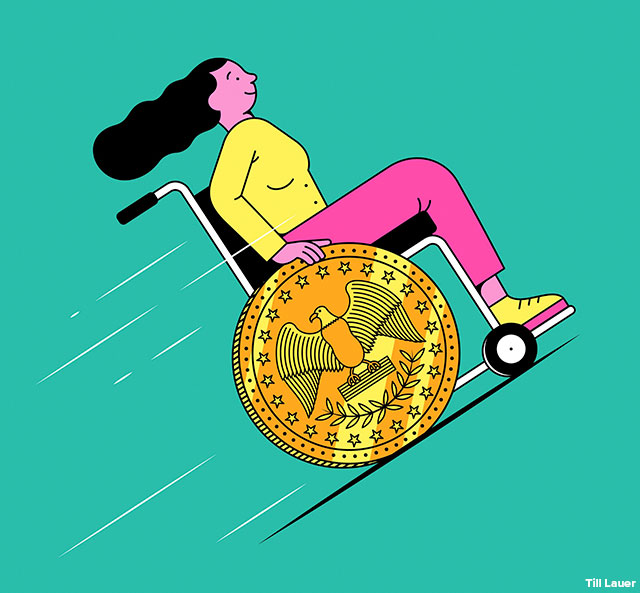Advocates for tax-favored ABLE accounts have spread the word about the benefit of putting at least part of the pandemic relief check in one.
By Ann Carrns
February 26, 2021
Special savings accounts for people with disabilities are getting fresh attention, as a way to safely put aside all or part of federal stimulus payments.
ABLE accounts, as they are known, were introduced in 2016 as a way to give disabled people greater financial security and more independence. Disabled people can save money in the tax-favored accounts without risking the loss of need-based government benefits, like health insurance or supplemental income.
Modeled partly on 529 college savings plans, ABLE (Achieving a Better Life Experience) accounts were created by federal legislation, but just a tiny fraction of the eight million eligible Americans have opened one. Forty-three states and Washington, D.C., now offer ABLE, with more than 75,000 accounts holding $538 million at the end of September, according to AKF Consulting Group, an adviser to state investment programs.
Various factors have weighed on the popularity of the accounts, including concern about high fees, a delay in final federal rules governing the accounts and worries that Medicaid may try to recoup payments from the funds after the holder’s death.
But interest has recently picked up, at least in part because federal pandemic relief has put cash in people’s hands, disability experts say. ABLE advocates have spread the word about the benefit of saving at least part of a stimulus check in the special accounts.
“It is a good idea,” said Miranda Kennedy, director of the ABLE National Resource Center, which is managed by the National Disability Institute.
In January, for instance, more than 700 accounts were opened in Virginia’s ABLE Now program — a monthly record since the program’s debut just over four years ago, said Mary Morris, its chief executive. Contributions in December roughly quadrupled from a year earlier.
Here’s why the accounts are attractive. Many people with disabilities struggle financially and rely on federal aid. But in general, a disabled person can’t have more than $2,000 in savings or other assets to qualify for Medicaid health coverage or Supplemental Security Income, which helps low-income disabled people.
Stimulus payments are not treated as income, and there are no restrictions on how the money can be spent. But if the recipient doesn’t spend the cash within 12 months, it counts against asset limits and could jeopardize benefits.
If the money is deposited in an ABLE account, it doesn’t count toward the $2,000 cap. It can be saved or invested and spent later on a variety of disability-related needs that arise, like housing, transportation, education and training.
Disabled people working toward independence can save for a down payment for an apartment or a wheelchair-accessible car. Or the funds can be used to save for specialized therapy or legal fees.
“It’s incredibly helpful to save for those bigger expenses,” said Bethany Lilly, senior director of income policy with the Arc, a nonprofit organization that works on behalf of people with intellectual and developmental disabilities.
In the first round of stimulus payments, individuals got up to $1,200, based on income; in the second round, up to $600. The third round, which is subject to congressional negotiations, is expected to be $1,400, but income caps may be lower.
“By putting it into an ABLE account, it’s an emergency fund,” Ms. Morris of ABLE Now said. “It’s a really nice opportunity.”
Some families have hesitated to use ABLE accounts because some have high account and investment fees. Increasing the number of participants, account proponents say, could help bring down costs. Many states have formed partnerships to better market the accounts, said Andrea Feirstein, managing director of AKF Consulting Group.
Also, legislation reintroduced in Congress aims to expand the pool of people who qualify for the accounts. Currently, to be eligible for an ABLE account, someone must have been disabled by age 26. The ABLE Age Adjustment Act would raise the age threshold to 46. Such a move would increase the pool of eligible people to about 14 million, Ms. Feirstein said.
Here are some questions and answers about ABLE accounts:
Do I have to open an account in my home state?
No. Most state ABLE programs accept out-of-state participants. Some states may offer lower fees. And some offer state tax breaks for contributions, so it makes sense to check your own state’s plan first. (There is no federal tax deduction for ABLE contributions, but interest and investment gains are tax free when spent on qualified disability expenses.)
Which states don’t offer ABLE accounts?
Hawaii, Idaho, Maine, North Dakota, South Dakota, Utah and Wisconsin currently don’t have active plans.
How much money can I contribute to an ABLE account?
The maximum contribution for 2021 is $15,000. Disabled people who work can also save an additional amount from their earnings —usually, about $12,000 (the amount varies by state), for a total of $27,000. Anyone, including family members and employers, can contribute to the account. It’s also possible to roll over money from a 529 college savings account. There are also caps on total account balances. Limits vary by state, but generally, ABLE balances can grow up to $100,000 without interfering with government benefits.
Are all disabled people eligible for federal stimulus payments?
Rules for the first two rounds meant that an estimated 400,000 disabled adults were disqualified because they were claimed as dependents on someone else’s tax return — a common situation for people with intellectual or developmental disabilities, said Ms. Lilly of the Arc. The oversight is expected to be corrected in the third round of payments to be distributed this year, she said, but it doesn’t appear that a retroactive fix will be applied to the earlier stimulus payments.
Reprinted with permission from The New York Times. Click here to view this article on the New York Times website.
